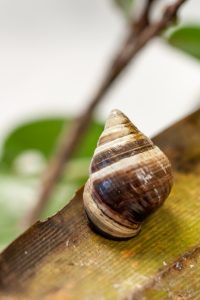Hawaiian tree snail George, a member of the Achatinella apexfulva species and the last of his kind, died on New Year’s Day. Likely an old age for a snail, George was 14 when he died.
While George never lived in an actual forest, he was still a symbol of the struggles facing endangered Hawaiian snails.
He was born in a captive breeding facility at the University of Hawaii at Mānoa in the early 2000s. The last 10 known Achatinella apexfulva were brought into a University of Hawaii lab to try to increase their numbers,George among them. But after a pathogen outbreak in the lab where he lived, the rest of his kin died and he became the only surviving member of his species. That’s when he got given the name Lonesome George.

George was described as “old and grizzled” and a “bit of a hermit” who would stay in his shell at times when most other nocturnal snails would emerge, David Sischo, the snail extinction prevention programme coordinator for the Hawaii Invertebrate Programme, told The Guardian.
However, he was not completely lonely, given he was visited everyday by hundreds, if not thousands, of schoolchildren from the local area.
Scientists hoped that George, a hermaphrodite would mate, but his solitary life eliminated the possibility. For over 10 years, researchers searched for another member of the species for George to mate with, but the search was in vain.
On the Hawaiian islands, where climate change and invasive predators have had a damaging effect on native animals and insects, George’s death represents the decline of the island’s biodiversity as a whole.
“I’m sad, but really, I’m more angry because this was such a special species, and so few people knew about it,” Rebecca Rundell, an evolutionary biologist with State University of New York who used to care for George, told The Guardian.
His death takes place amid a crisis for native snails in the Hawaiian Islands. Snails which were once found in abundance here are now in serious trouble, most only found on a single ridge or valley. The loss of a species is also a knock to the area’s ecosystem.
For now, George’s shell and body are being preserved, as well as a live sample of his “foot”, which was sent to the Frozen Zoo in San Diego. The aim is to one day clone him and revive the species.















